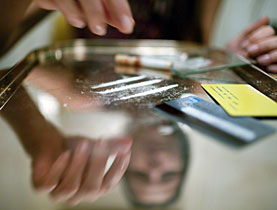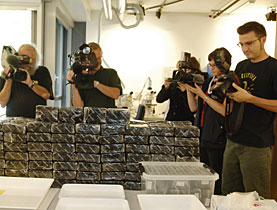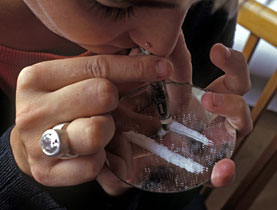West African gangs “dominate” cocaine trade

A number of major recent drug busts in Switzerland have underlined the growing influence of West Africans in the cocaine trafficking trade and the methods used.
In February, a Lausanne court jailed two Nigerian asylum seekers working for a Togolese criminal group for smuggling cocaine into Switzerland and money laundering following a Europe-wide investigation known as “Inox”.
In all, some 35 people have been arrested as part of the investigation, accused of smuggling 15 kilograms of cocaine from West Africa between 2005 and 2008.
The Inox case is just one of a handful of major cocaine busts announced by Swiss police in recent months. On Wednesday, Neuchâtel cantonal police reported it had broken up a West African cocaine ring following the arrests of 30 people across Europe.
A day earlier, Lucerne police said it had dismantled a Nigerian cocaine network, involving 30 people, which smuggled the drug into Switzerland from France and the Netherlands by train using female drug mules. Other cases involving Nigerians were reported in the city of Biel in February and in canton Vaud in January.
“The numerous recent cases are the result of a determined campaign by the cantons to break down open street-level cocaine trafficking,” Roger Flury, an illegal drugs expert at the Federal Police Office, told swissinfo.
“West Africans are clearly the most dominant group, followed by people from the Dominican Republic. They were very visible and active; it was only a question of time.”
Massive increases
Recent years have seen massive increases of cocaine smuggling from South America into Europe via West Africa. The United Nations Office on Drugs and Crime (UNODC) estimates that 27 per cent, or 40 tons of cocaine consumed annually in Europe, worth $1.8 billion (SFr2 billion), pass through West Africa.
Cocaine is mostly transported to West Africa in large quantities on sea vessels, often concealed in containers. In West Africa the cocaine is stockpiled, repackaged and much of it shipped to Europe on commercial flights in the luggage, clothing or intestines of drug mules. According to the UNODC, criminal groups have started using a “shotgun approach”, whereby a large number of couriers are dispatched on the same flight.
Upon arrival the cocaine is distributed via West African criminal groups throughout Europe.
“Before, most cocaine entered Europe via Spain and the Netherlands, but Portugal has grown in importance alongside Spain as an entry point linked to the Portuguese colonies in Guinea Bissau and Cape Verde,” said Thomas Pietchmann, a UNODC researcher.
Togo-based group
In the recent Inox case, a Togo-based criminal group smuggled cocaine to Europe via Brussels airport using drugs mules. The mules were met by Nigerian gang members who distributed the drugs on their behalf throughout Europe, including Switzerland, collected the profits and redistributed them back to Togo.
To obtain visas to enter Switzerland, dealers placed orders with Swiss companies at trade fairs in Germany and then requested commercial invitations to travel to Switzerland.
Instead of transferring money back to Africa via Western Union, a money transfer service, or using other traditional transfer routes, drug funds were converted into hundreds of second-hand cars, which were bought from a Lebanese garage owner in canton Bern and shipped to Togo.
According to Jean-Christophe Sauterel, spokesman for the Vaud cantonal police, although the Inox case is “not that exceptional”, it illustrates well the situation in Switzerland.
Endless battle
“The networks are organised, with sellers coming here from the various countries in West Africa to deal cocaine. Once in Switzerland they are looked after by a network that can even organise asylum requests,” he said.
“The Nigerians are very active and often at the head of the network. If not, people from Togo, Guinea and Guinea Bissau. Sometimes they are organised by clan or country of origin, but other times it’s mixed.”
Despite the recent successes, fighting cocaine smuggling is “an endless battle” according to Sauterel.
“As soon as one network is dismantled another is in place very quickly. They are very mobile and flexible and organised. There is no permanent hierarchy so a seller can arrive and quickly become responsible for a network,” he explained.
“The police can’t eradicate drug smuggling. We don’t have the means and we can never do so. In canton Vaud we have taken precautions to limit the visibility of drug dealing but with the constant pressure on street dealing the problem has been diluted. Dealing is no longer open in the streets but in public transport or in apartments. It’s not just in Lausanne but all towns in the canton are affected,” said Sauterel.
“We don’t pretend to be able to resolve the problem, which is much wider than the competence of the police alone.”
swissinfo, Simon Bradley
According to the United Nations Office on Drugs and Crime, the drug trafficking problem in West Africa is still small by the standards of West Asia, the Caribbean or Central America. But it is growing exponentially and threatening to turn the region into an epicentre of lawlessness and instability.
A declining US cocaine market and a rising European market appear to have prompted South American cocaine traffickers to make use of certain areas of West Africa as transit zones.
Drug seizures from West Africa are growing dramatically. At least 46 tons of cocaine have been seized on route to Europe via West Africa since 2005. Prior to that the entire continent rarely seized a ton. It is estimated that around 50 tons of cocaine transit through West Africa every year.
Most cocaine entering Africa from South America makes landfall around one of two hubs, centred on Guinea-Bissau and Ghana. The drugs are then trafficked between West African countries before being shipped out on commercial air flights.
Some 62% of the incidents and 55% of cocaine seized involved four countries: Senegal, Nigeria, Guinea and Mali. Senegal and Nigeria were the source of the greatest volumes seized.
A drugs mule can be paid up to SFr1,500 per visit to smuggle cocaine into Switzerland. The mule can carry up to 1kg of cocaine packed into condoms, which are swallowed.
The amount of cocaine smuggled into Switzerland is unknown. In 2008 the Federal Customs Office confiscated 145kg of cocaine, compared with 217kg in 2007.
In the 1980s a gram of cocaine cost between SFr500 and SFr600 in Switzerland, depending on its purity. Today it costs between SFr40 and SFr120, which is as little as SFr8 a line.
In Switzerland, 60% of the foreign drug traffickers arrested are West African, from a wide range of countries.

In compliance with the JTI standards
More: SWI swissinfo.ch certified by the Journalism Trust Initiative



You can find an overview of ongoing debates with our journalists here. Please join us!
If you want to start a conversation about a topic raised in this article or want to report factual errors, email us at english@swissinfo.ch.